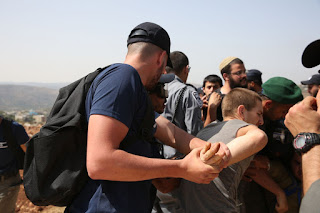On July 4th, 2018, as many Israelis were celebrating with their American peers the 242nd anniversary of the adoption of the US' Declaration of Independence, the screams of the residents of Khan al-Ahmar, a Palestinian village populated by the Jahalin Bedouin tribe, were left seemingly unheard, as following the Supreme Court's ruling that green-lighted the evictors, Israeli bulldozers roamed through the Judean desert east to Jerusalem into the narrow, sandy streets of the small hamlet, dismantling its houses and turning it into yet another uninhabited dune in the endless desert.
 |
| Evacuation of Khan al-Ahmar |
 |
| Khan al-Ahmar residents resist evacuation |
As Israeli left-wing activists and party leaders, alongside members of numerous human rights organizations, were gasping in disturbance and shock following the events in Khan al-Ahmar, they have been targeted with several waves of severe criticism from the Israeli society itself, regarding their response to the demolition of the Palestinian village as rather hypocritical - since images resembling those seen in Khan al-Ahmar haven't been uncommon in the Israeli media lately - yet they weren't picturing the demolitions of Palestinian villages, but those of Israeli West Bank outposts, such as the notorious settlements of Amona, Netiv Ha'avot and Western Tapuach.
However, as we all unfortunately know, images tend to be deceptive. The settlement of Amona was constructed in 1996 by a group of Israeli teenage settlers from Ofra on land that, until being nationalized in 1995, belonged to Palestinians from the village of Silwad, and was used to grow crops on. It was recognized by the Israeli government in 2004 after receiving sponsorship from the Israeli Ministry of Construction - in contradiction with the Oslo Accords and the international law. In 2006, after the settlement's leadership was charged with property theft and illegal construction, a partial evacuation took place - yet a full evacuation was deferred up until 2017 when the residents of the illegal outpost were moved to a new settlement near Ofra.
Unlike Amona, while Netiv Ha'avot and Western Tapuach were, in fact, illegal settlements, they weren't distinct outposts at all - yet unauthorized neighborhoods of the existing settlements Elazar and Tapuach, and were built on private Palestinian land in the last few years. As unauthorized building, especially such that occurs among Palestinian villages and on private Palestinian land, contradicts the Israeli law, the authorities have taken measures against the newly-constructed areas, sending bulldozers accompanied by law enforcement and border control officers - yet the residents of the outposts - which have been home to the greatest known concentration of Kahanists and Jewish extremists - refused to give up without a fight, using bricks and bleach as weapons and sending 11 officers to the nearest hospital.
The case with Khan al-Ahmar, on the other hand, differs vastly from its Israeli counterparts. The hamlet has existed for over 87 years, as it is listed in the 1931 census of Palestine carried out by the authorities of the British Mandate, according to which it was home to 27 residents. Many of its recently evicted residents are members of the Bedouin Jahalin tribe - a tribe that was expelled from the Negev desert in southern Israel in 1952 by the Israeli army. The following year the expelled families moved to the West Bank, which was under Jordanian jurisdiction, and joined the local community of Khan al-Ahmar.


Yet the eviction of the residents of Khan al-Ahmar isn't a mere act of cruelty - the village is located in E1, a 12 sq. kilometer (6.3 sq. mile) area that lies between Jerusalem and the nearby West Bank settlement of Ma'ale Adumim. The area is located in the larger Area C which is under Israeli military control. For the last several decades, Israel has wished to build up the area with settlements, yet was met with intense pressure and disapproval from the international community. However, it seems that the demolition of Khan al-Ahmar is the opening shot of the plan whose goal is to be reached by expelling the local population and connecting the nearby outposts with Jerusalem, essentially bifurcating the West Bank - while not only committing a war crime, but leading to what has been described over the years as the nail in the coffin of the two-state solution.
 |
| Khan al-Ahmar and E1 (by Middle East Eye) |


Comments
Post a Comment